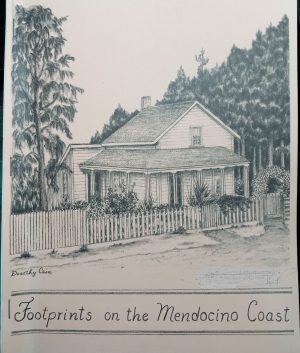Last week in the Mendocino Community Library I was sorting through donated books and found a publication called Footprints on the Mendocino Coast with a drawing of a strangely familiar house on its cover. I recognized the house almost immediately and opened the book to learn more. Published in 1970 by the Mendocino County Historical Society, the book is the Reverend John Simpson Ross’ account of his life on the coast, written after he retired at 75 from his (very) active ministry. Turns out the Caspar mystery house was his.

Reverend Ross left more than footprints on the Mendocino coast.
As I go to and from the Caspar Shul or Community Center, I often notice an old house on Caspar Road. It is old and down at the heels, but it has an attractive wrap-around porch and some distinctive detailing. There’s an old orchard in the yard to its south, and a rickety water tower. Somebody took some pains with its design and construction back in the day, but the house is closed up tight now with a No Trespassing sign nailed to its front window. I wonder about its history and current emptiness.
I know a bit about Reverend Ross, but I have never known where he lived. He was the first Baptist minister to arrive in these parts, in 1869, and he devoted over 30 more years to riding up and down the coast on horseback—from Rockport to Point Arena—ministering to the faithful, marrying and burying hundreds of them, and establishing some churches. He built the Baptist church (now the Caspar Shul) in Caspar, but first he needed to construct a house for his family.
Ross came here from the Ottawa Valley in Ontario because of failing health. Some of his congregants from Canada had resettled in Caspar “and were working in the woods, mill, or lumber yard.” They assured him the “fresh, moist air from the Pacific” would restore his vitality. Among his old friends was Duncan McCallum, the superintendent of the Caspar mill. He introduced Ross to J.G. Jackson, the owner of the mill, and the latter offered Ross $100 worth of lumber to build a house for his family, still back in Canada. Jackson was not one of the Baptist faithful, but perhaps he saw in Reverend Ross a civilizing influence for rough and rowdy Caspar.
McCallum drew up a design for the house, and work began on it in April, 1870. As Ross was virtually penniless, he required lots of pro bono help to get it done. Joseph Ward oversaw the construction, and men from the mill framed, sided and roofed it. Carpenters with time on their hands worked on the interior. Andrew Fooks offered to help build the chimney and bake oven; Ross assisted by gathering stone for it.
The upper story of the house had no proper ceiling yet, but fortuitously the Tolo was wrecked off Caspar Point and “a great quantity of good lumber floated around in the harbor, eventually washing up below Carson’s bluff.” With McCallum’s help and a team of horses from the mill, Ross salvaged enough to “ceil the upper story, and build a wood house and cow barn.”
Tune in next week for another chapter of “Little House.” In the meantime, the Kelley House is open from 11:00 AM to 3:00 PM Thursday through Sunday. Contact us at info@kelleyhousemuseum.org to make an appointment, or just drop by. Walking tours of the historic district depart from the Kelley House regularly; for tour schedule, visit www.kelleyhousemuseum.org.